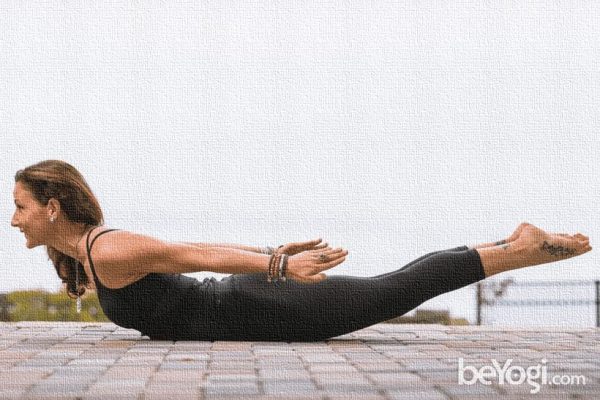
Practicing Locust Pose Aids Digestion
The “locust pose” is a yoga pose that is also known as “Shalabhasana” in Sanskrit. It is a beginners yoga backbend pose that strengthens the muscles of the back, buttocks, and legs. Locus pose known to stimulates the abdominal organs and aids digestion, improves posture and counteracts the effects of prolonged sitting in addition to toning the muscles of the buttocks and helps alleviate sciatica.
Avoid this pose; if you have a recent or chronic injury to the back. Pregnant women should approach this pose with caution and may choose to keep the legs on the ground for a modified version – Healthy Life
LEVEL: Beginner
Anatomy: Abs, Chest, Hamstrings, Shoulders, Upper Back
Pose Type: Backbend, Heart Opener, Prone
Sanskrit: Salabhasana (sha-la-BAHS-anna) salabha = locust
BENEFITS:
- Strengthens the back muscles, hamstrings, and core
- Stimulates the abdominal organs
- Aids digestion
- Stretches the chest, shoulders, and abdomen
- Improves posture
CONTRAINDICATIONS:
- Back or neck injury
- Pregnancy
- Headache
HOW TO:
- Begin lying on your stomach with your legs extended, the tops of your feet pressing into the floor, and your chin resting on the mat.
- Extend your arms along the sides of your body, palms facing up. Engage your core and firm your pelvis against the floor.
- As you inhale, lengthen your legs and spine, reaching your toes toward the back of your space.
- Exhale and lift your head, chest, arms, and legs off the ground. Roll your shoulders back and extend your arms behind you, so they are parallel with the floor. Reach through your fingertips and firm your back muscles.
- Contract the legs to help you lift, keeping your knees, ankles, and big toes together. Gaze forward, being careful to keep the back of your neck long.
- Hold Locust pose for three to five breaths. Slowly release to the floor on an exhale.
MODIFY OR REPLACE:
Alternatives:
Dhanurasana (Bow pose)
Modifications:
Clasp your hands together behind your back. As you inhale and lift the torso, reach the arms straight back and up.
SEQUENCING TIPS:
Before:
Chaturanga Dandasana (Four-Limbed Staff pose)
Urdhva Mukha Svanasana (Upward-Facing Dog)
After:
Dhanurasana (Bow pose)
Setu Bandha Sarvangasana (Bridge pose)
TEACHING CUES:
- Look forward and down to keep your neck in line with your spine.
- Turn the big toes together and keep them touching as you lift.
- With each inhale, lift a bit higher off the floor.
- With each exhale, lengthen the spine, arms, and legs.
VARIATIONS:
- Makarasana (Crocodile pose)
WATCH OUT FOR:
- Gripping the gluteus muscles
- External rotation of the legs
- Shoulder blades not rooted on the back
- Pressure in low back
- Chin lifted too high
This article and image published here with prior permission from beyogi.com
Author: HealthyLife | Posted on: December 13, 2023
« Nadabrahma Tibetan Humming Meditation New Year Resolutions: Suggestions to Honor your Body and Mind »






















Write a comment